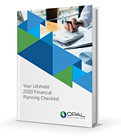How to Prep Your Estate Planning Strategy Now if Biden’s Proposal Becomes Law
By Jesse Giordano, CFP® | October 31, 2020For better or worse, presidential elections have a way of impacting our financial lives. We’re on the home stretch of this election cycle, but questions and concerns are already swirling over the financial implications of either outcome, regardless of who wins.

Vice President Joe Biden has proposed reducing the gift and estate tax exemption, which is relevant to high-net-worth individuals. The Tax Cuts and Jobs Act of 2017 doubled this amount to $11.58 million per person, allowing married couples to transfer roughly $23 million without having to pay a gift or estate tax. It’s set to expire at the end of 2025, bringing it down to approximately $6 million. However, a Biden administration could reduce it sooner—or bring the exemption amount down even further. Of course, none of us knows for certain how things will play out. Even if Biden does take the White House and make these proposed changes, Congress would still need to pass the final version.
Be that as it may, it never hurts to think ahead and begin strategizing sooner rather than later. A spousal lifetime access trust (SLAT) is a powerful planning tool for married couples should the gift and estate tax exemption be reduced.
How Do Spousal Lifetime Access Trusts (SLATs) Work?
A SLAT is a type of irrevocable trust. That means once it’s created, it cannot be modified without the express consent of its beneficiaries. With a SLAT, one spouse gifts assets to the other without having to pay a gift tax. What’s more, the assets in the SLAT are not included in the donor spouse’s gross estate. As such, when the donor spouse passes away, the SLAT will not be subject to estate tax. In essence, the donor spouse is taking their gift and estate tax exemption and applying it to the value of the assets they put into the SLAT.
Another benefit is that a SLAT can be structured so that any growth of its assets can also be excluded from the beneficiary spouse’s gross estate. In other words, when the beneficiary spouse dies, that appreciation isn’t subject to estate tax, either. For these reasons, SLATs can be a great estate planning tool that helps married couples leave more of their wealth to each other and their heirs.
What This All Means for Estate Planning
Taking advantage of a SLAT now is one way to avoid the repercussions if the gift and estate tax exemption decreases sooner than expected. It’s worth mentioning that they’re flexible by design. For example, you can set it up so that only the beneficiary spouse takes distributions from the SLAT assets. Upon their death, that wealth could then be transferred to your heirs. Alternatively, you could make it so that the beneficiary spouse and your children all have access to these assets at the same time.
The main takeaway is that it’s important to structure your SLAT in a way that makes the most sense for you and your family. There are also some additional complexities to work through. For example, if you fund a SLAT with jointly owned assets, they could be included in the beneficiary spouse’s estate—which would wash out the donor spouse’s exemption and defeat the purpose of creating this kind of trust.
Time Is of the Essence
Now for the most important detail: Estate planning acted upon before December 31, 2020 will allow you to preserve the current gift and estate tax exemption as is, no matter who wins the election. Opening a SLAT and funding it up to the maximum amount before the year ends could help preserve your family’s wealth over the long term.
At Opal Wealth Advisors, we’re advising high-net-worth individuals to start making plans now to allow for a smooth transition later down the road. Again, these changes to the tax code may never come to pass—but if they do, you want to be ready. Now is the time to connect with a skilled financial advisor who understands all the complexities of estate planning. Reach out to us today to see if creating a SLAT is a smart financial move for you and your spouse.
Be a Smart Investor
Stay up-to-date with industry-leading information and news delivered straight to your inbox.
Get our timely insights delivered to your inbox (Blog)
Please remember that past performance may not be indicative of future results. Different types of investments involve varying degrees of risk, and there can be no assurance that the future performance of any specific investment, investment strategy, or product (including the investments and/or investment strategies recommended or undertaken by Opal Wealth Advisors, LLC [“OWA]), or any non-investment related content, made reference to directly or indirectly in this commentary will be profitable, equal any corresponding indicated historical performance level(s), be suitable for your portfolio or individual situation, or prove successful. Due to various factors, including changing market conditions and/or applicable laws, the content may no longer be reflective of current opinions or positions. Moreover, you should not assume that any discussion or information contained in this commentary serves as the receipt of, or as a substitute for, personalized investment advice from OWA. OWA is neither a law firm, nor a certified public accounting firm, and no portion of the commentary content should be construed as legal or accounting advice. A copy of the OWA’s current written disclosure Brochure discussing our advisory services and fees continues to remain available upon request or at www.opalwealthadvisors.com. Please Remember: If you are a OWA client, please contact OWA, in writing, if there are any changes in your personal/financial situation or investment objectives for the purpose of reviewing/evaluating/revising our previous recommendations and/or services, or if you would like to impose, add, or to modify any reasonable restrictions to our investment advisory services. Unless, and until, you notify us, in writing, to the contrary, we shall continue to provide services as we do currently. Please Also Remember to advise us if you have not been receiving account statements (at least quarterly) from the account custodian.



